This article was co-authored by Laura Marusinec, MD. Dr. Marusinec is a board certified Pediatrician at the Children's Hospital of Wisconsin, where she is on the Clinical Practice Council. She received her M.D. from the Medical College of Wisconsin School of Medicine in 1995 and completed her residency at the Medical College of Wisconsin in Pediatrics in 1998. She is a member of the American Medical Writers Association and the Society for Pediatric Urgent Care.
There are 8 references cited in this article, which can be found at the bottom of the page.
wikiHow marks an article as reader-approved once it receives enough positive feedback. In this case, 80% of readers who voted found the article helpful, earning it our reader-approved status.
This article has been viewed 140,787 times.
A sprained wrist is an injury to the ligaments that connect the small bones of the wrist (called carpal bones) together. The most common ligament injured in the wrist is the scapho-lunate ligament, which connects the scaphoid bone to the lunate bone.[1] Wrist sprains have a wide range of severity depending on the degree of stretch or tearing to the ligament. The severity of your wrist sprain will dictate how you look after it at home or whether you need to see a health professional.
Steps
Looking After a Mildly Sprained Wrist
-
1Rest your wrist and be patient. Minor wrist sprains are often caused by repetitive tasks or hyperextending the joint by falling on an outstretched hand.[2] Take a break from repetitive tasks if that's what you think led to your wrist injury. Talk to your boss about switching to a different activity for a week or so. If the sprain is exercise-related, then you may be working out too aggressively or with bad form — consult with a personal trainer.
- A mild wrist strain is often categorized as a Grade I sprain, which implies that ligaments are stretched a little too far, but not significantly.[3]
- Tolerable pain, mild inflammation or swelling, and some loss of movement and/or strength in the wrist are common symptoms of Grade I wrist sprains.
-
2Ice your sprained wrist. The application of ice is an effective treatment for essentially all minor musculoskeletal injuries, including wrist sprains.[4] Apply the ice to the most tender part of your wrist in order to reduce the swelling and pain. Ice should be applied for 10-15 minutes every 2-3 hours for a couple of days, then reduce the frequency as the pain and swelling subside.
- Compressing the ice against your wrist with an elastic wrap will also help control the inflammation, but don't tie it too tight because complete restriction of blood flow could cause more damage to your hand and wrist.
- Always wrap ice or frozen gel packs in a thin towel in order to prevent frostbite on your skin.
Advertisement -
3Use a basic wrist support. Wrapping your wrist in an Ace or tensor bandage, surgical tape, or a simple neoprene wrist support will offer a small degree of joint support and allow you to compress ice to your wrist easier, but the biggest benefit is likely psychological — essentially it's a visual reminder to take it easy with your wrist for a short period of time.[5]
- Wrap your wrist from your knuckles all the way up to the middle of your forearm, overlapping the elastic wrap as you go.[6]
- The wrist wrap, tape, or neoprene wrist support should be snug, but not cutting off your circulation — make sure your hand doesn't turn blue, get cold or start to tingle.
-
4Do some light wrist stretches. After the pain and inflammation have subsided, do some light stretches if your wrist feels stiff. Mild strains and sprains respond well to some light stretching because it relieves tension, promotes blood flow and increases flexibility.[7] In general, hold stretches for about 30 seconds and do them 3-5x daily until the mobility returns to your wrist.
- You can stretch both wrists at the same time by forming the "prayer pose" with your hands (the palms of both hands together in front of your face with your elbows bent). Put pressure against your hands by raising the level of your elbows until you feel a nice stretch in your injured wrist. Check with your doctor, trainer, or physical therapist for more wrist stretches if needed.
- Consider applying some moist heat to your wrist prior to stretching it — it will make the tendons and ligaments more pliable.
Looking After a Moderately Sprained Wrist
-
1Take an over-the-counter medication. Non-steroidal anti-inflammatories (NSAIDs) such as ibuprofen, naproxen or aspirin can be short-term solutions to help you deal with significant pain or inflammation in your wrist.[8] Keep in mind that these drugs can be hard on your stomach, kidneys, and liver, so it's best not to use them for more than 2 weeks at a stretch. Do not give aspirin to children under 18
- Talk to your doctor before starting new medications if you have medical problems, take medications, or have allergies to medications.
- Alternatively, you can rub a pain-relieving cream or gel directly into your sore wrist.
- Keeping your wrist elevated can also help reduce swelling.
- Moderate wrist sprains, usually called Grade II sprains, involve significant pain, inflammation, and often bruising due to ligament tearing.
- Grade II wrist sprains may feel more unstable and lead to more hand weakness than Grade I wrist sprains.
-
2Be more diligent with icing. A moderate or Grade II wrist sprain involves greater swelling because ligament fibers are torn, although it's not completely severed.[9] As such, you'll need to be more diligent with your icing routine in addition to taking some anti-inflammatory medication. The sooner you can apply cold therapy to a Grade II sprain the better, because blood vessels will contract in diameter and restrict blood flow and subsequent swelling. For a more serious sprain, ice should be applied for 10-15 minutes every hour for the initial day or two, then reduce the frequency as the pain and swelling subside.
- If you don't have any ice or gel packs, then use a frozen bag of veggies from your freezer — peas or corn works great.
-
3Wear a wrist splint or brace. Since instability and weakness is more of a concern with a Grade II wrist sprain, a more supportive wrist splint or brace should be worn.[10] A splint or brace is not primarily psychological, as it will restrict movement (immobilize) and offer substantial support if you need to use your hand for something.
- Check with your doctor on which type of splint or brace is recommended.
- Make sure you position your wrist in a neutral position when you tighten the wrist splint or brace.
- Grade II sprains may need to be immobilized with a brace or splint for 1-2 weeks, which can result in stiffness and reduced range of motion when you take it off.[11]
-
4Plan on some rehabilitation. Once your Grade II wrist sprain starts to heal after a few weeks, you may need some rehabilitation to gain back your strength and mobility. You can do this at home or you can see a physical therapist, who will show you specific and tailored strengthening exercises for your wrist and hand.[12]
- To build strength once your wrist feels better, try squeezing a ball: with your arm outstretched and your palm facing up, squeeze a rubber ball (a racquetball works well) with your fingers for 30 seconds at a time and repeat 10-20x per day.[13]
- Other activities that will help build strength in your wrist include lifting light weights, bowling, playing racket sports, and working in your yard (pulling weeds, etc.). Don't start these types of activities until your doctor or therapist tells you to do so.
Seeking Medical Attention
-
1See your doctor. In instances of significant wrist trauma that leads to severe pain, swelling, bruising, and/or loss of hand function, it's best to see your family physician or emergency department immediately so that the correct diagnosis can be made. Grade III wrist sprains involve completely severed ligaments, which will need surgery to repair.[14] Other serious wrist conditions that your doctor should consider are fractures, dislocations, inflammatory arthritis (such as rheumatoid arthritis or gout), carpal tunnel syndrome, infection, and severe tendonitis.
- X-rays, bone scans, MRI, and nerve conductance studies are modalities that your doctor may use to help diagnose your wrist issue. Your doctor may also send you for a blood test to rule out rheumatoid arthritis or gout.
- You should also see your doctor if you still have symptoms after treating a sprain at home for more than 2 weeks or if the symptoms are getting worse.
- Other symptoms that may be signs of a fracture include significant swelling, bruising, tenderness, deformity, and causes of the injury like falling onto your wrist and sports injuries.
- Children tend to have more fractures than sprains of the wrist.
-
2See a chiropractor or osteopath. Chiropractors and osteopaths are joint specialists who focus on establishing normal motion and function of the spinal and peripheral joints, including the wrist. If your wrist sprain primarily involves a jammed or slightly dislocated carpal bone, then the chiropractor / osteopath will use manual joint manipulation, also called an adjustment, to unjam or reposition the affected joint. You can often hear a "popping" or "cracking" sound with an adjustment.
- Although a single adjustment can sometimes completely relieve your wrist pain and restore full range of motion, more than likely it will take a few treatments to notice significant results.
- Wrist adjustments are not appropriate for wrist fractures, infections, or inflammatory arthritis.
-
3Talk to your doctor about a wrist injection. An injection of steroid medication near or into a ligament, tendon, or joint can quickly reduce inflammation and allow normal, pain-free movement of your wrist again.[15] Cortisone injections are only indicated for serious or chronic wrist sprains. The most common preparations used are prednisolone, dexamethasone, and triamcinolone.
- Potential complications of corticosteroid injections include infection, bleeding, tendon weakening, local muscle atrophy, and nerve irritation / damage.
- If corticosteroid injections fail to provide adequate resolution for your wrist, then surgery should be considered.
-
4Talk to your doctor about wrist surgery. Surgery for chronic wrist pain is the last resort and should only be considered after all other non-invasive therapies are proven ineffective, although if you experience a traumatic Grade III sprain, then surgery will be your first option to repair the severed ligaments.[16] Wrist surgery involves reconnecting the severed ligament to the associated carpal bone, sometimes with pins or plates for stabilization.
- Wrist ligament surgery takes from 6-8 weeks to heal, although several months of rehabilitation may be needed to regain normal strength and range of motion[17]
- Possible complications from wrist surgery include local infection, allergic reaction to anesthesia, nerve damage, paralysis, and chronic swelling / pain.
Warning
- See your doctor immediately if you experience any of the following signs or symptoms: quickly escalating severe wrist pain, paralysis or numbness in your hands or arms, wrist joint at a strange angle, high fever, sudden unexplained weight loss.
References
- ↑ http://www.assh.org/handcare/hand-arm-injuries/wrist-sprains
- ↑ http://orthoinfo.aaos.org/topic.cfm?topic=a00023
- ↑ http://www.nlm.nih.gov/medlineplus/ency/patientinstructions/000568.htm
- ↑ http://www.urmc.rochester.edu/encyclopedia/content.aspx?ContentTypeID=1&ContentID=4483
- ↑ http://orthopedics.about.com/cs/sprainsstrains/a/wristsprain_2.htm
- ↑ http://orthopedics.about.com/cs/sprainsstrains/a/wristsprain_2.htm
- ↑ http://www.mayoclinic.org/healthy-lifestyle/fitness/in-depth/stretching/art-20047931
- ↑ http://www.nlm.nih.gov/medlineplus/ency/patientinstructions/000568.htm
- ↑ http://orthoinfo.aaos.org/topic.cfm?topic=a00023
- ↑ http://www.nlm.nih.gov/medlineplus/ency/patientinstructions/000568.htm
- ↑ http://orthoinfo.aaos.org/topic.cfm?topic=a00023
- ↑ http://www.spine-health.com/treatment/physical-therapy/physical-therapy-benefits-back-pain
- ↑ http://www.nlm.nih.gov/medlineplus/ency/patientinstructions/000568.htm
- ↑ http://www.nlm.nih.gov/medlineplus/ency/patientinstructions/000568.htm
- ↑ http://www.mayoclinic.org/tests-procedures/cortisone-shots/basics/definition/prc-20014455
- ↑ http://www.assh.org/handcare/hand-arm-injuries/wrist-sprains
- ↑ http://orthoinfo.aaos.org/topic.cfm?topic=a00023
- ↑ http://www.nlm.nih.gov/medlineplus/ency/patientinstructions/000568.htm
About This Article
You can look after a sprained wrist by wrapping it with an elastic bandage to support the joint and allowing it to rest so it can heal. You can also reduce swelling by icing it for 10-15 minutes every 2 hours. After a few days, you might try doing some light wrist and arm stretches to relieve tension and increase blood flow to the area. Additionally, to alleviate pain, try taking an anti-inflammatory such as Ibuprofen or Aspirin. Make sure to see your doctor if your sprain doesn’t improve after a few days. To learn how to build strength in your wrist after a sprain, read more from our Doctor co-author.

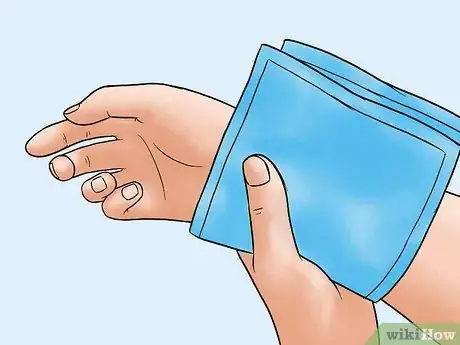
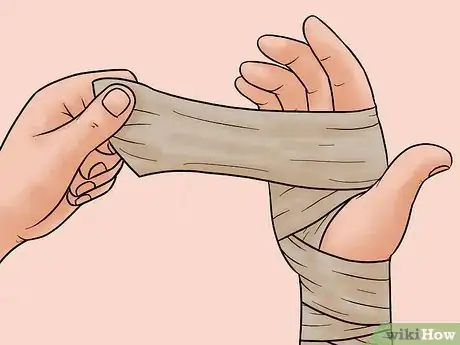
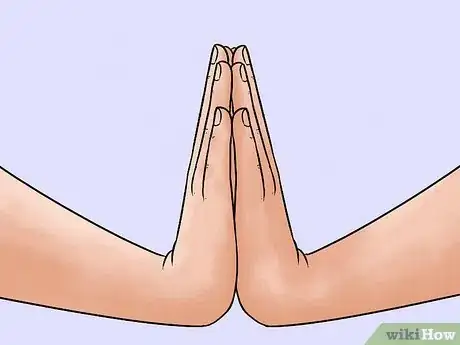







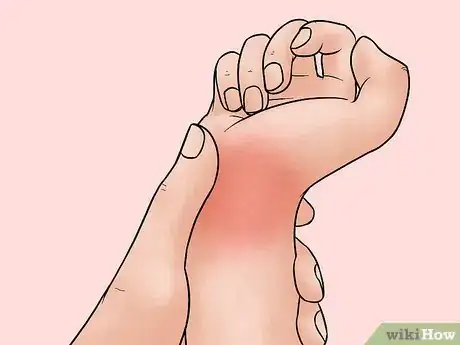

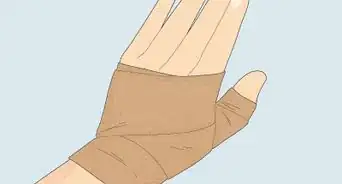
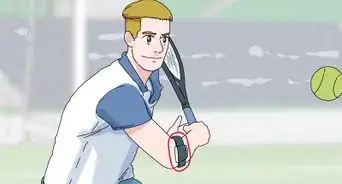
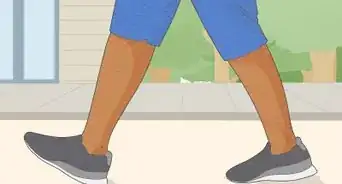
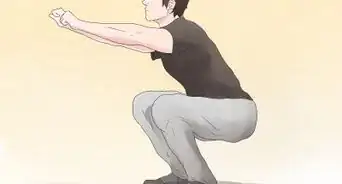


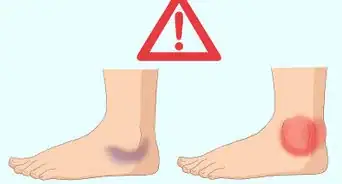
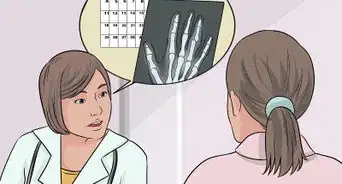
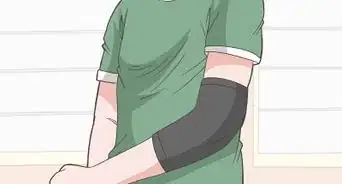












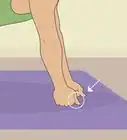





































Medical Disclaimer
The content of this article is not intended to be a substitute for professional medical advice, examination, diagnosis, or treatment. You should always contact your doctor or other qualified healthcare professional before starting, changing, or stopping any kind of health treatment.
Read More...